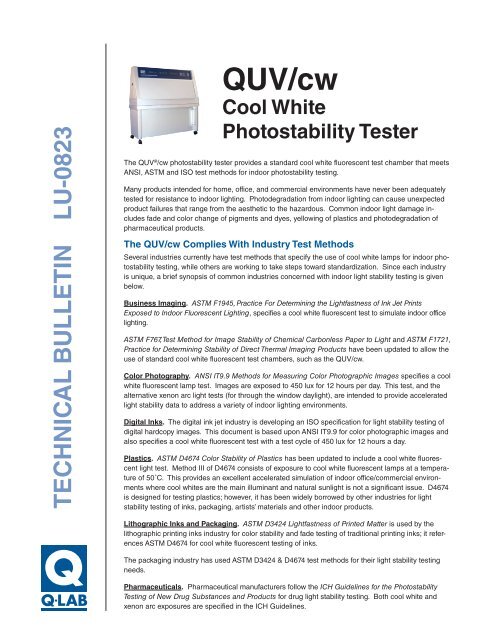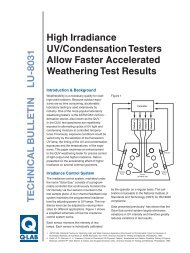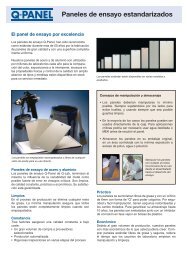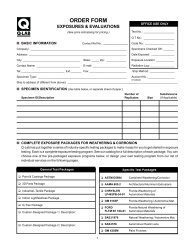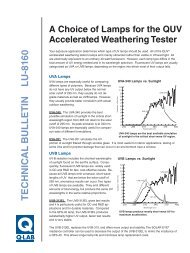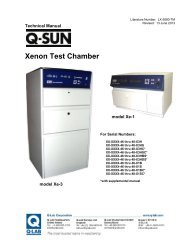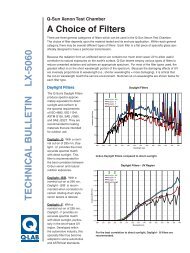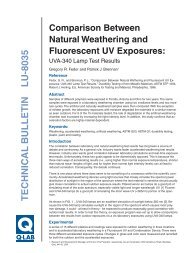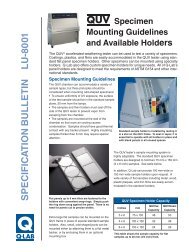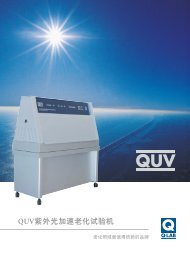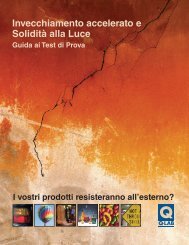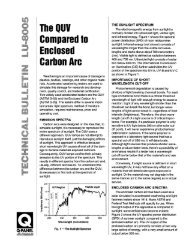LU-0823 - QUV/cw Summary - Q-Lab
LU-0823 - QUV/cw Summary - Q-Lab
LU-0823 - QUV/cw Summary - Q-Lab
You also want an ePaper? Increase the reach of your titles
YUMPU automatically turns print PDFs into web optimized ePapers that Google loves.
TECHNICAL BULLETIN <strong>LU</strong>-<strong>0823</strong><br />
<strong>QUV</strong>/<strong>cw</strong><br />
Cool White<br />
Photostability Tester<br />
The <strong>QUV</strong> ® /<strong>cw</strong> photostability tester provides a standard cool white fluorescent test chamber that meets<br />
ANSI, ASTM and ISO test methods for indoor photostability testing.<br />
Many products intended for home, office, and commercial environments have never been adequately<br />
tested for resistance to indoor lighting. Photodegradation from indoor lighting can cause unexpected<br />
product failures that range from the aesthetic to the hazardous. Common indoor light damage includes<br />
fade and color change of pigments and dyes, yellowing of plastics and photodegradation of<br />
pharmaceutical products.<br />
The <strong>QUV</strong>/<strong>cw</strong> Complies With Industry Test Methods<br />
Several industries currently have test methods that specify the use of cool white lamps for indoor photostability<br />
testing, while others are working to take steps toward standardization. Since each industry<br />
is unique, a brief synopsis of common industries concerned with indoor light stability testing is given<br />
below.<br />
Business Imaging. ASTM F1945, Practice For Determining the Lightfastness of Ink Jet Prints<br />
Exposed to Indoor Fluorescent Lighting, specifies a cool white fluorescent test to simulate indoor office<br />
lighting.<br />
ASTM F767, Test Method for Image Stability of Chemical Carbonless Paper to Light and ASTM F1721,<br />
Practice for Determining Stability of Direct Thermal Imaging Products have been updated to allow the<br />
use of standard cool white fluorescent test chambers, such as the <strong>QUV</strong>/<strong>cw</strong>.<br />
Color Photography. ANSI IT9.9 Methods for Measuring Color Photographic Images specifies a cool<br />
white fluorescent lamp test. Images are exposed to 450 lux for 12 hours per day. This test, and the<br />
alternative xenon arc light tests (for through the window daylight), are intended to provide accelerated<br />
light stability data to address a variety of indoor lighting environments.<br />
Digital Inks. The digital ink jet industry is developing an ISO specification for light stability testing of<br />
digital hardcopy images. This document is based upon ANSI IT9.9 for color photographic images and<br />
also specifies a cool white fluorescent test with a test cycle of 450 lux for 12 hours a day.<br />
Plastics. ASTM D4674 Color Stability of Plastics has been updated to include a cool white fluorescent<br />
light test. Method III of D4674 consists of exposure to cool white fluorescent lamps at a temperature<br />
of 50˚C. This provides an excellent accelerated simulation of indoor office/commercial environments<br />
where cool whites are the main illuminant and natural sunlight is not a significant issue. D4674<br />
is designed for testing plastics; however, it has been widely borrowed by other industries for light<br />
stability testing of inks, packaging, artists’ materials and other indoor products.<br />
Lithographic Inks and Packaging. ASTM D3424 Lightfastness of Printed Matter is used by the<br />
lithographic printing inks industry for color stability and fade testing of traditional printing inks; it references<br />
ASTM D4674 for cool white fluorescent testing of inks.<br />
The packaging industry has used ASTM D3424 & D4674 test methods for their light stability testing<br />
needs.<br />
Pharmaceuticals. Pharmaceutical manufacturers follow the ICH Guidelines for the Photostability<br />
Testing of New Drug Substances and Products for drug light stability testing. Both cool white and<br />
xenon arc exposures are specified in the ICH Guidelines.
Standardized Cool White Photostability Test Equipment<br />
Cool white fluorescent testing has typically<br />
been conducted using “light box” devices that<br />
do not properly control important test parameters,<br />
such as temperature and irradiance (light<br />
intensity). Inconsistencies in the construction<br />
and operation of these devices make it difficult<br />
to produce accurate, repeatable and reproducible<br />
test results.<br />
A standardized, affordable and easy-to-use<br />
tester is available with the <strong>QUV</strong>/<strong>cw</strong>. By providing<br />
a controlled environment, the <strong>QUV</strong>/<strong>cw</strong><br />
effectively reproduces and accelerates indoor<br />
lighting conditions encountered in office and<br />
commercial environments, as well as retail<br />
display lighting.<br />
Why Use the <strong>QUV</strong>/<strong>cw</strong> with Cool White Fluorescent Lamps?<br />
Irradiance (W/m 2 2 ) )<br />
0.50<br />
0.40<br />
0.30<br />
0.20<br />
0.10<br />
0.00<br />
Spectral Power Distribution of Cool White Lamps<br />
in a <strong>QUV</strong>/<strong>cw</strong> versus a Typical Office<br />
Note: The<br />
light intensity<br />
in a <strong>QUV</strong>/<strong>cw</strong><br />
can be set<br />
between 4k lux<br />
and 20k lux.<br />
Spectral Power Distribution of Cool White Lamps<br />
in a <strong>QUV</strong>/<strong>cw</strong> versus a Typical Office<br />
Cool Whites in<br />
Typical Office (1k lux)<br />
Cool Whites in Typical<br />
Office (1 klx)<br />
300 350 400 450 500 550 600 650 700 750<br />
Wavelength (nm)<br />
Wavelength (nm)<br />
Cool Whites<br />
in <strong>QUV</strong>/<strong>cw</strong><br />
Cool Whites in<br />
(20k lux)<br />
The cool white fluorescent lamp spectrum is representative<br />
of visible light encountered in indoor commercial or<br />
office environments.<br />
The <strong>QUV</strong>/<strong>cw</strong> is an adaptation of the <strong>QUV</strong> accelerated weathering tester, which uses fluorescent UV lamps to<br />
test outdoor product durability. The <strong>QUV</strong>/<strong>cw</strong> has the same features as the <strong>QUV</strong>/se, but is modified specifically<br />
to use fluorescent cool white lamps for accelerated indoor product durability testing.<br />
Control of Irradiance. A photostability tester must control irradiance if it is to achieve repeatable and reproducible<br />
results. Changes in light intensity may affect the speed of material degradation, while changes in<br />
wavelength may affect both speed and the type of material degradation. The SOLAR EYE ® irradiance control<br />
allows the user to choose the desired level of irradiance. In the <strong>QUV</strong>/<strong>cw</strong>, you can increase cool white lamp<br />
intensity by up to 20 times the typical office illuminance of 1k lux. The illuminance range is 4k-20k lux (see the<br />
SPD chart above). With the SOLAR EYE feedback loop system, the irradiance is continuously monitored and<br />
precisely maintained, automatically.<br />
Control of Temperature. Photochemical reactions are not usually temperature sensitive. However, the rate of<br />
subsequent reactions are temperature dependent. Consequently, it is important to control the test temperature.<br />
Many researchers prefer to match the maximum temperature the material will be exposed to in a service<br />
environment. In the <strong>QUV</strong>/<strong>cw</strong>, the temperature can be set at any point between 35˚C - 80˚C, depending on<br />
irradiance and ambient room temperature.<br />
Programmable. The <strong>QUV</strong>/<strong>cw</strong> can be programmed to perform various test cycles (e.g. 100% light, alternating<br />
light & dark cycles, etc.). This flexibility allows the user to better simulate end use applications where dark<br />
periods may be encountered.<br />
Calibratable. To ensure the accuracy of any irradiance control system, it is necessary to periodically calibrate<br />
the sensors. The <strong>QUV</strong> tester’s patented AUTOCAL ® system uses the CR10 radiometer to measure the light intensity<br />
of the cool white lamps and electronically transfer the calibration from the radiometer to the SOLAR EYE<br />
controller. Calibrations with the CR10/<strong>cw</strong> are traceable to the U.S. National Institute of Standards and Technology.<br />
Compliance. The <strong>QUV</strong>/<strong>cw</strong> Photostability Tester provides a standard cool white fluorescent test chamber that<br />
allows you to conduct reproducible and repeatable tests in accordance to ANSI, ASTM and ISO test methods.<br />
Q-<strong>Lab</strong> Corporation<br />
Q-<strong>Lab</strong> Headquarters<br />
Westlake, OH USA<br />
Tel: +1-440-835-8700<br />
info@q-lab.com<br />
Q-<strong>Lab</strong> Florida<br />
Homestead, FL USA<br />
Tel: +1-305-245-5600<br />
q-lab@q-lab.com<br />
Q-<strong>Lab</strong> Europe, Ltd.<br />
Bolton, England<br />
Tel: +44-1204-861616<br />
info.eu@q-lab.com<br />
Q-<strong>Lab</strong> Arizona<br />
Buckeye, AZ USA<br />
Tel: +1-623-386-5140<br />
q-lab@q-lab.com<br />
www.q-lab.com<br />
Q-<strong>Lab</strong> Deutschland GmbH<br />
Saarbrücken, Germany<br />
Tel: +49-681-857470<br />
vertrieb@q-lab.com<br />
Q-<strong>Lab</strong> China 中 国 代 表 处<br />
Shanghai, China 中 国 上 海<br />
电 话 : +86-21-5879-7970<br />
info.cn@q-lab.com<br />
<strong>LU</strong>-<strong>0823</strong>.4 © 2013 Q-<strong>Lab</strong> Corporation. All Rights Reserved.<br />
Q-<strong>Lab</strong>, the Q-<strong>Lab</strong> logo, <strong>QUV</strong>, AUTOCAL and SOLAR EYE are registered trademarks of Q-<strong>Lab</strong> Corporation.


